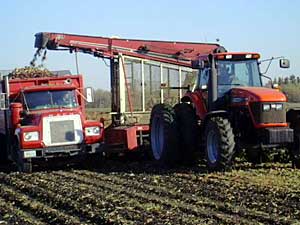|
Photos
Your Voice
|
Red River Valley farmers anticipate a profitable harvest
October 13, 2003
 |
| Dan Anderson will harvest 160 acres of beets near Stephen, Minnesota (MPR Photo/Bpb Reha) |
Stephen, Minn. — This year, the weather didn't conspire against farmers in the Red River Valley. Unlike the past two summers, there were no floods from heavy rains. Crops look good. Although the final production numbers aren't in, the year looks better than expected.
Usually a good crop means there is too much grain available, driving market prices down. But that's not happening. Cole Gustafson, an applied economics professor at North Dakota State University, says a weak U.S. dollar is helping farmers.
 | |||
"As the value of the dollar drops, it becomes more encouraging, our exports become more competitive. We're likely to see strong wheat prices," says Gustafson. "We could have the best possible situation. We have a large crop and relatively good prices."
Gustafson says the market for beans is also doing well. He says livestock feed is just one use for soybeans.
"Because there is so many new uses for soybeans, industrial uses for the oils, the soybean oil, for cattle feed. The cattle complex is driving a lot of it," says Gustafson. "Because of the record high prices for livestock, thats creating more demand for soybean meal."
Gustafson says farmers need $4 a bushel for wheat and $6 a bushel for beans to make money. Friday, the closing price for wheat on the Chicago board of trade fell below the $3.50 mark. But soybeans climbed above the $7 mark.
 | |||
George Sinner has been a banker in eastern North Dakota for the past 20 years. He says interest rates on loans are low. They're as little as 4 percent on short term operating loans. Sinner says thats important, because the average debt load for his customers is about $500,000.
"There's going to be some real strengthing in farm country this year," Sinner says. "Because this going to be a great year and I think there will be some money stuck away. Maybe in the terms of extra pay downs or improvements in facilities and equipment. Some of those kind of things are going to happen."
Sinner says the biggest worry for farmers remains the weather. At this point any kind of moisture is welcome. Drought-like conditions hit the Red River Valley in August.
"If that continues into next year, we could be facing a pretty serious drought. Crop yields could drop dramatically," says Sinner. "I know that the federal government has always come through with some kind of aid, but it's never been enough to make up for the loss of a crop."
 | |||
But Sinner is optimistic that farmers will make money this year.
"Your probably going to see more new pickups than normal this fall," says Sinner.
The sugar beet harvest can be an ordeal. People work long hours to pull the crop from the ground and move it to storage piles. Warm weather is the enemy. If temperatures get too hot, the beets spoil and farmers lose money.
Unseasonably warm temperatures are slowing the sugar beet harvest in the Red River Valley. Temperatures have hit the 80s, and sugar beet companies don't want to pile the beets outside where they could spoil.
But farmers remain optimistic. Dan Anderson is completing his first year farming. The 20 year-old is a full time college student. He's missing a few weeks of class to harvest his crop. He says he's learned a lot this year.
 | |||
"(There were) More bills than I expected. I didn't budget for everything that happened," says Anderson. "I had a few breakdowns. My tractor needed to be overhauled a hundred hours into the season, so that was fun."
Anderson's farm is near Stephen, in northwest Minnesota. He'll harvest a 160 acres of sugar beets. To cut expenses, he's shared equipment with his dad. Still the bills keep adding up.
"I got machinery to pay for. I got a loan to pay for all the chemicals and seed and stuff like that I put into it," says Anderson. "The rest is hopefully mine, depending on what else I have to spend it on."
If there are no other unplanned expenses Anderson figures he'll make about $9500 from his crop this year. He's already planning for next year. He wants to find more land to farm.
He says he'll need to if he wants to make farming his only source of income. This winter he'll go to school and get a part time job. Anderson says he's proud of himself. He's always dreamed of farming and now he is.
|
News Headlines
|
Related Subjects
|
